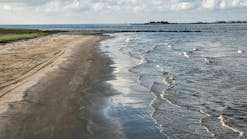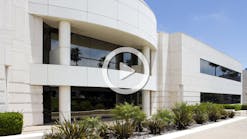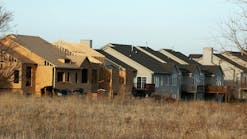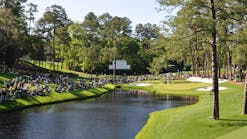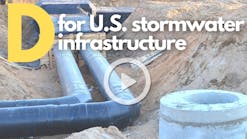About the author: Chris Richgels, P.E., is western region technical support for Agru America. Richgels can be reached at 916.218.8375.
The new Industrial General Permit for Storm Water Discharges Associated with Industrial Activities is being adopted by the U.S. In California, for example, the permit will become effective on July 1, 2015. Landfill operations and closures will be regulated under the new permit. In particular, closed landfills and closed areas of active landfills will be regulated for total suspended solids (TSS), total dissolved solids (TDS) and turbidity.
Some Complications
As any landfill operator can tell you, application of landfill final cover does not imply an end to landfill slope maintenance. Final cover systems are complex designs intended to hold materials that are incompatible with each other to a certain degree—sometimes on steep slopes. These materials can include (from the top down): a soil erosion protective layer; a subdrainage layer (usually a geocomposite drainage material); a geomembrane barrier layer; and a soil intermediate/foundation soil layer. It is not a natural act for soil and plastic to stick together—hence the incompatibility a final cover design must accommodate.
Adding to the complexity, typical state final cover design regulations require advanced design effort for slopes steeper than 3H:1V with respect to system veneer stability. The capital cost of landfill design, permitting and construction actually encourages steeper slope designs and construction, however, to dilute those capital expenses into a reasonably sized component of the waste disposal fee.
In addition to the veneer slope stability concerns, steeper slopes mean faster-moving storm water runoff; thus, higher, sometimes destructive, erosive force as well. With final cover systems costing between $2 and $3 per square foot on the low end, a powerful storm can cause hundreds of thousands of dollars in damage in a matter of minutes during the storm peak.
In California, this is such a concern to state agencies—which could be left holding the bag for landfill care post closure—that the state adopted new corrective action cost-funding requirements in 2010 for such scenarios. The funding regulation requires municipal solid waste landfills (Class III) that are nominally required to design drainage systems for a 100-year storm to provide cost estimates and funding mechanisms to repair damage to the drainage infrastructure from a 1,000-year storm event.
For privately owned and operated sites, this can result in new drainage conveyance system designs being kicked up a size to accommodate the 1,000-year storm water flows, thus avoiding the financial liability of having to create this funding mechanism during the site post-closure period. Still, erosive damage to the final cover system is a real concern in regard to discharge compliance with the general permit and repairing slope damage from intense storm systems. A “soil-less” final cover system would be desirable from this design perspective.
Crazy Horse
The Crazy Horse Landfill closure near Salinas, Calif., received a completed final cover in December 2012. The total surface area receiving final cover was 68 acres, including an approximate 30-acre topdeck (5% grade) and sideslopes up to 2H:1V.
The site normally would be required to institute best management practices to capture and reduce sediment discharge from erosion of the soil erosion protection layer. The Crazy Horse Landfill, however, does not have a soil component, but rather a “mechanically erosion-resistant layer” as permitted in Section 21090(a)(3)(A)(2) of Title 27 of the California Code of Regulations. This layer consists of a high-density polyethylene artificial turf tufted through a double-layered polypropylene geotextile backing. This artificial turf is placed over a structured liner low- density polyethylene geomembrane that provides a built-in drainage matrix with a calendared studded profile on the topside of the membrane and veneer stability with calendared grips on the reverse side (Agru America’s SuperGripnet geomembrane). Combined, the materials are known as ClosureTurf.
Testing It Out
Storm water erosion and discharge quality concerns were essentially eliminated at the Crazy Horse Landfill by using this final cover system. The permitting process had to demonstrate that ClosureTurf was an acceptable alternative final cover system to the state prescriptive standard design. Through a variety of laboratory and field testing programs, the hydraulic capacity, veneer stability and environmental exposure longevity were used to demonstrate the effectiveness of the ClosureTurf system to the approving state agency—the Central Coast Regional Water Quality Control Board—as the approved final cover system for the site.
Since closure construction was completed in 2012, the site has experienced several severe Pacific storms blowing in from nearby Monterey Bay. The site elevation peaks at 630 ft above mean sea level. Monterey Bay is visible from the site topdeck, so the induced storm uplift generates fairly intense precipitation for the California climate. For example, the design 100-year, five-minute precipitation intensity for the site is 6.2 in. per hour. The 1,000-year intensity is 8.1 in. per hour. This rainfall level produced an estimate peak site discharge of 165 cu ft per second from the closed facility. A soil-based final cover system would be at risk for severe erosive damage and heavy sediment discharge; however, storm water runoff from the ClosureTurf final cover system has suffered no erosive damage to date. Storm water discharge quality from the system has an appearance best described as “drinkable” because it is so clear.
Other Cases
The Tangipahoa Parish Landfill, located in Independence, La., was under corrective action for excess sediment discharge. In 2013, approximately 22 acres of the site were closed using ClosureTurf. According to a paper presented at the 2014 International Congress on Environmental Geotechnics 2014 (de Abreu and Franklin), the first storm water sampling event indicated a 97% minimum decline in the storm water constituents of concern (turbidity, TSS, total organic carbon and total recoverable iron).
In May 2014, the Pensacola area of western Florida was struck by a severe storm event. This storm dumped 22 in. of rain in a 24-hour period, causing extensive damage and some loss of life. Some of that rain fell on the Saufley Field disposal site near the Saufley Field Navy Air Base. One hourly precipitation intensity was estimated to be between the 200- and 500-year storm events. The Saufley Field disposal site had been closed in 2013 with the ClosureTurf system. Post-storm repair at Saufley involved only two man-days of infill repair along some of the slopes.
The response of this geosynthetic final cover system to extreme storm events has demonstrated compliance to the new general permit water quality requirements and durability to some of the worst forces of nature.
Download: Here

